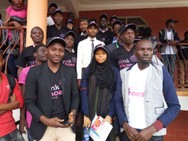Sex is a reality, and we are proud to be sex-positive. As long as people are engaging in consensual experiences, safe2choose encourages and supports it. We do so by sharing accurate and stigma-free information, as well as facilitating access to safe abortion methods.
True autonomy comes with deep understanding of your options, your risks and your benefits. Therefore, one can never be autonomous without education on sexual and reproductive health and rights. Sadly, that’s exactly what we have witnessed among medical students from Uganda.
Local statistics confirm what we know to be happening all around the world: unmarried people are having sex. Among young women aged 15 to 24, more than one in three from the never-married group have already had sex, and nearly one in five unmarried women is currently sexually active.
These numbers are coming from the Guttmacher Institute’s studies, who estimates that “1,2 million unintended pregnancies occurred in Uganda in 2008”, accounting for more than half of the country’s 2,2 million pregnancies that year. At the same period, unsafe induced abortions accounted for 26% of maternal mortality national rates.
Still according to the study, “adolescents and young adults are particularly at risk for unintended pregnancy”. One of the reasons behind it is the stigma around premarital sex in Uganda. Young people are more subject to moral judgements and don’t feel comfortable seeking information on family planning and sexual health. Despite their academic environment, medical students face the same issues.
This is why safe2choose decided to co-host an introductory training on “Sexual and Reproductive Health and Rights”, in partnership with Medical Students For Choice (MSFC) and HowToUseAbortionPill.org. A total of 55 soon-to-be doctors attended the activity to learn more about the topic, which is systematically overlooked by universities’ curriculum.
The meeting was part of a bigger effort to improve safe abortion access in the country. It all started earlier this year, when safe2choose visited Kampala and met with MSFC and other local organizations. We want to understand the origins of such deeply-rooted stigmas and to find ways out of it.
Medical students share their personal experiences
To prepare for the training, we invited 60 medical students (45% female, 55% male) to answer a baseline survey and we used the results to guide our discussions.
The answers were aligned with national statistics, and more than a third of them said they used no contraception at all. One in four people in the group reported using the withdrawal method as a contraceptive.
It didn’t strike us as a surprise when 50% of the group said they knew somebody who had interrupted a pregnancy. The bitter part was learning that 33% of them knew somebody who had either died or suffered heavy consequences from an unsafe abortion.
Do you know anybody who has had an abortion?
Do you know anybody who has had heavy complications or died from an unsafe abortion?
Finally, 60% of the students told us that Internet was their main source of information on sexual and reproductive health and rights. Lectures appeared behind options such as friends and medical staff.
Where do you find your Sexual and Reproductive Health Information?
Some important questions remained. We want to know how online groups such as safe2choose and HowToUseAbortionPill.org can make a real difference on-the-ground.
We would also like to know how to expand the efforts of engaged groups like Medical Students for Choice, as well as other major stakeholders who joined us in Kampala, as did Marie Stopes Uganda, the Center for Health, Human Rights and Development (CEHURD) and the medical professionals, Dr Charles and Dr Andrew.
Most solutions are yet to come. But, for starters, spreading accurate, science-based and non-stigmatized information online is something we can and have been doing. Finding ways to directly approach health professionals and student leaders, who are ready to spread the word is another goal.
Above all, we’re committed to listen to our users and making sure the work we do is meaningful to them. We know they can give us the answer.




